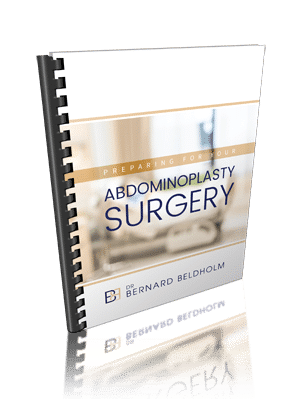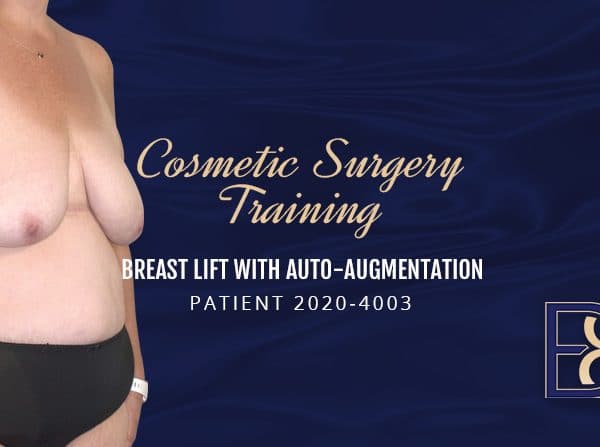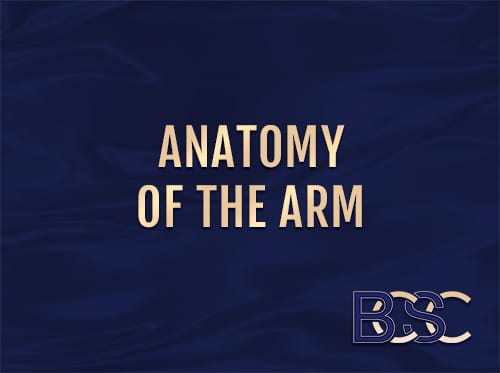How I Perform Lipo-Abdominoplasty: A Research-Based Approach
Written for cosmetic surgeons who want to learn about the benefits and proper technique for modern lip-abdominoplasty surgery.
This training article was written for cosmetic surgeons who want to learn about the benefits and proper technique for modern lip-abdominoplasty surgery. This surgical guide provides research and detailed instructions for performing the operation.
Abdominoplasty has come a long way in the last century. New techniques aim to elevate aesthetic outcomes and complication rates. Today, we will talk about the steps to performing a successful lipo-abdominoplasty with the aid of liposuction in detail. Performed correctly, the surgical method described here delivers excellent results for patients wishing to remove excess skin and fat from the abdominal area while reducing post-operative complications and discomfort.
The purpose of this article is to provide a step-by-step framework for performing liposuction-based abdominoplasty using current modalities. Based on extensive research and my own personal experience in the operating room, the steps described here will contour the abdominal region and effectively, lower the risk of seroma, and eliminate the need for drains.
All abdominoplasties aim to alter abdominal contours. Modern combination techniques achieve better results than older abdominoplasty methods. I have found that the more aggressively we approach removal of fat in body contouring, the higher the level of patient success. Adding liposuction to the procedure helps accomplish this.
In the past, it was considered unsafe to perform tummy tuck surgery and liposuction concurrently. However, today we know that combination techniques are proven successful when the correct steps are taken.
As surgeons, we always want patients to report high ratings. However, the choice of technique goes beyond patient reviews. Reduced complication risks are extremely important, as are reducing pain and inconvenience after surgery. This benefits both the patient and the surgeon. Performing multiple procedures at once has many benefits, and doing so can be more effective than abdominoplasty alone.8
We will start with a brief overview of the changes to how we approached abdominoplasty in the past compared to body contouring today. Starting with basic abdominoplasty, we will discuss how and why liposuction can be added, and finally, the steps for how to perform liposuction-based abdominoplasty surgery. This is how I did the operation prior to 2016. Today, I use the VASER liposuction technique (the Lipo-abdominoplasty), which we will cover in a future blog post.
Abdominoplasty and suction-assisted lipectomy (liposuction) have traditionally been separate procedures
In the past, the belief was that it was dangerous to combine abdominoplasty with suction-assisted lipectomy (liposuction). The fear was that the it would compromise too many vascular structures within the abdominal flap, resulting in necrosis. Traditional wide lateral dissection and heavy undermining often damage important lymphatics and blood vessels in the surgical area, making liposuction inadvisable.
However, modern techniques keep these vital structure intact, allowing combination procedures to become a possibility. Research shows that intensive liposuction performed alongside today’s abdominoplasty techniques results in better patient outcomes.7
Traditional abdominoplasty has limitations
Traditional abdominoplasty involves wide undermining of the abdominal flap, resulting in a compromised blood supply to the surgical site. Liposuction is not advisable because of this. The traditional abdominoplasty method falls short of what we can offer patients today. However it is not uncommon to see surgeons still performing surgery this way. Today, we can achieve better results without the need for wide undermining. All it takes are some changes to the technique used in the operating room.
Huger divided the vascular supply of the abdominal region into three zones: the central abdomen, which is supplies by deep and superficial epigastric arteries, the peripheral abdomen, which is supplied by the inter- and sub-costal and lumbar perforators, and the inferior abdomen, supplied by a deep network of arteries.7
In traditional abdominoplasty, the vascular zone in the inferior abdomen is more or less cut away and discarded. The blood supply to the central abdomen is transected during abdominal flap elevation. Therefore, liposuction to the central abdomen is not recommended.7 This central abdomen is typically an area that would greatly benefit from liposuction, so you can begin to see why traditional abdominoplasty has aesthetic limitations.
But what if the blood supply to the central abdomen could be preserved? Recent research supports the fact that preserving blood supply to the abdominal flap allows the surgeon to perform extensive lipo without compromising the skin. Certain perforators can be spared during elevation so that this may occur.7 The surgical method described at the end of this article will show you how to do this.
Advancements in High Lateral Tension Abdominoplasty
When Lockwood introduced the high lateral tension abdominoplasty in 1995, everything changed. His technique showed that limited undermining could be done without sacrificing results. Most importantly, it preserved blood flow.5 Surgeons who followed Lockwood’s protocol saw great potential in the efficacy of the procedure. This new approach to surgery opened up the door for liposuction-based abdominoplasty as we know it today.
Adding suction-assisted lipectomy (liposuction) to abdominoplasty
Eventually, it became widely accepted that suction-assisted lipectomy (liposuction) and abdominoplasty can be performed at the same time. Liposuction-based abdominoplasty tends to give better results than traditional liposuction. Adding lipo achieves better subcutaneous fat reduction and skin retraction. Research also indicates that supplementing modern abdominoplasty with liposuction lowers the risk of complications by further limiting dissection.7,8,10
Why a combination approach is better
Studies support the premise that it is to perform extensive fat removal with suction-assisted lipectomy (liposuction) during abdominoplasty.7,8,10 When performed properly, it has significant aesthetic advantages compared to traditional abdominoplasty alone, and can even reduce complication rates. In my practice, I have seen a decrease in post-surgical problems thanks to a combination technique and operating above the Scarpa fascia.
This approach to abdominoplasty gives better results than classic abdominoplasty alone. Patients loved the results as well. In an evaluation of 360 patients, 99.2 percent of those who received a combination of liposuction alongside abdominoplasty reported success with their surgical outcome.9
Scarpa fascia preservation
A great result is not just about adding liposuction, of course. There are other changes we can make in the operating room. Limiting the surface area of dissection is another critical factor in achieving successful outcomes.
In my surgical method, the dissection is made in the tissue above the abdominal wall. A classic plane of dissection should be avoided in the lower abdominal region. A more superficial dissection in the infraumbilical area offers better results1 and preserves lymphatics. Scarpa fascia and deep fat compartment preservation has many advantages. It reduces hematoma and infection rates compared to traditional abdominoplasty while achieving equal aesthetic results. Leaving a thin layer on the fascia also decreases seroma formation.4 Importantly, it means we can offer patients a drainless Abdominoplasty.
Typical complications of surgery
A discussion of complications is important when considering which techniques will give the best patient outcomes. Abdominoplasty, like any surgery, can have undesirable effects that we must contend with. Seroma and hematoma are the most common complications linked to abdominoplasty. Infection, wound dehiscence, necrosis, blood loss, embolism, loss of sensation, and the need for scar revisions are also possibilities. The surgical steps I will describe reduce seroma formation, lower the risk of infection by eliminating drains, preserve blood flow, and reduce post-operative discomfort.
Using Drains
Nowadays, I do not believe drains are necessary. While many surgeons still use drains for Abdominoplasty, they are falling out of favor. There is no solid evidence that using drains lowers the chance of seroma development.
Drains are undesirable for many reasons. Aside from being cumbersome, they have been linked to longer hospital stays, increased risk of infection, and worse discomfort for the patient.6 For surgeons who still rely on drains, limiting dissection has been shown to significantly reduce the time that drains are needed.4 Liposuction may be used for this purpose.
In my method, drains are eliminated entirely. There are two reasons that make this possible. First, the use of liposuction limits dissection. Second, the tissue is dissected either just above the Scarpa fascia (which is how I preferred to do it at the time), or just below the Scarpa, taking care not to get too close to the abdominal wall in order to preserve lymphatics.
Current literature suggests that the seroma rate using this approach is low at around 1-2%. To date, my patients have had a zero percent seroma rate using this approach. The surgical method that follows is a drainless technique.
Performing the surgery: A step-by-step operation guide
Prior to 2016, I performed lipo-abdominoplasty exclusively. The steps below describe the method I used for performing modern lipo-abdominoplasty using specific techniques that maximize aesthetic outcomes for the patient while eliminating the need for drains. The total surgery time typically takes 4-5 hours. It is quite a long procedure. The liposuction part of the procedure can take up nearly a third of the total time.
This method involves aggressive liposuction in all areas without worry of bloody supply problems or necrosis. Using liposuction to dissect the tissue, there is no need for the extensive dissection required of a classic Abdominoplasty. This has many benefits. You will not need drains with this method.
- The steps of this operation are:
- Preparing the patient
- Liposuction to shape the abdomen
- Elevating the skin in a superficial plane
- Tightening the rectus abdominis muscles
- Creating a new belly button
- Marking and removing the lower abdominal skin
- Closing all layers
Step 1: Preparing the patient
First, I greet the patient in the anaesthetic bay to go over the all the final details of their procedure with them. While the patient and I have had plenty of time to discuss their wishes and expectations prior to surgery day, many patients feel a bit nervous just before surgery. It is critical to allow enough time to alleviate any concerns or last-minute questions the patient might have at this time.
I make initial markings at this stage with the patient standing upright. The aim of these markings is to plan the incision so that the scar may be easily hidden in underwear or a bikini after the surgery. It is helpful to ask the patient to bring the preferred style of underwear that they plan to wear after surgery for this purpose. Doing the markings together with the patient also allows them to have a say in the process, and they are more likely to be happy after the surgery.
Spirit level is used to make straight lines that will guide skin resection. The planned liposuction is also marked out. After the markings are finalized, my anaesthetist provides the patient with any necessary pre-meds.
Once in the operating room, the patient lays on the operating table and the anaesthetist delivers the recommended dose of anaesthesia. When the patient is fully sedated, position the patient on the operating table with their arms outstretched on the arm boards. The patient will be prepped with Betadine and draped. A strict aseptic technique will be used.
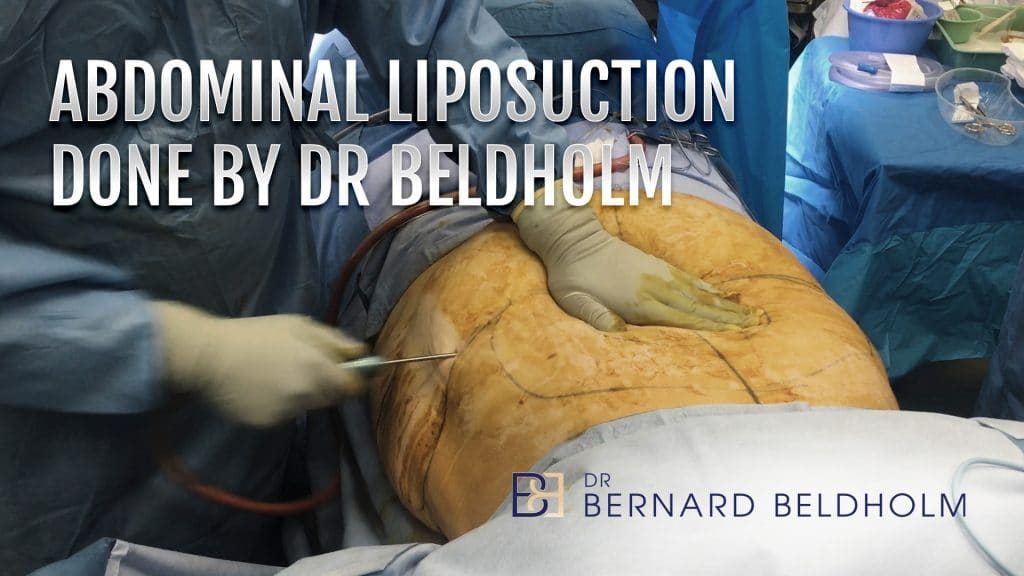
Liposuction is performed initially and extensively. It can take 1-1.5 hours depending on the amount of fat that needs to be removed. There are two steps to performing abdominal liposuction:
I begin by making access holes for the liposuction using a nr11 scalpel. The first step is to inject what is called the “wetting solution”. This solution contains local anaesthetic as well as adrenalin. This allows for fat removal. It also gives pain relief for up to 12 hours after surgery. The wetting solution used is 1 liter of normal saline containing 400 mg lignocaine and 1 ml of 1:1000 adrenaline. The usual amount of fluid used is from 3-6 liters, depending on the size of the patient. A dosage is 35 mg of lignocaine per kg of patient weight. In some studies, the dose used is up to 55 mg per kg. However, I prefer a conservative dose. The fluid is injected gently into deep the areas marked for liposuction.
The next step is to remove the fat. Liposuction is performed using 4-6 mm metal liposuction cannulas. There are a range of lipo cannulas, and they all have different names. The one that I use is called a mercedes cannulae due to the fact that it has three holes at the tip.
Once liposuction is completed, you will see that the tissues are empty of fat. The skin will appear far looser than before. It can be moved quite easily, which allows the skin to be pulled down taut for a nice, flat result. After liposuctioning the abdomen, I again prep the area with Betadine and change gloves.
2. Initial dissection
Next, I proceed with the initial dissection. The first incision is made on the line that has been marked out previously. I find that a normal incision tends to have better healing than a beveled one.
Any blood vessels that open up during dissection can be sealed with Diathermy.
Next, I dissect the skin off the underlying tissues. The way that this is done in a liposuction-based tummy tuck is quite different from traditional abdominoplasty. I dissect the tissues staying above the Scarpa fascia up to the umbilicus, and then going below the Scarpa fascia. In the traditional tummy tuck the dissection is done on the fascia of the abdomen. But in the liposuction-based tummy tuck the dissection is made above this layer. This preserves lymphatics and promotes healing. It also minimizes the possibility of seroma formation, making drains unnecessary.
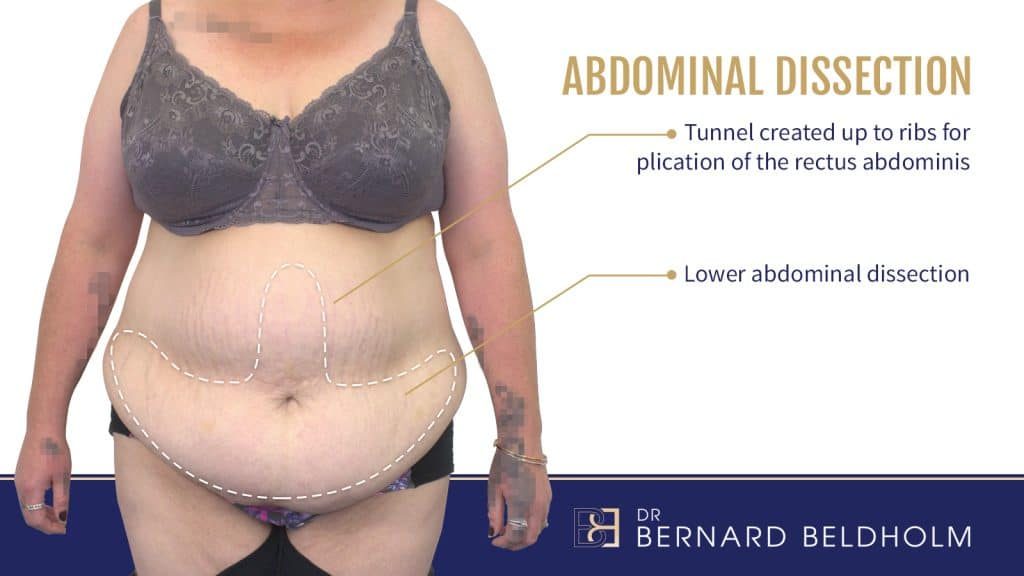
Tattoo blurred for privacy
Once I reach the belly button, the dissection is minimized and an epigastric tunnel is made down to the abdominal wall. This allows me to reach the rectus abdominis muscles and see how much separation exists between the muscles. The tunnel is dissected gently to avoid vascular damage, thereby preserving blood flow to the rectus muscle and skin.
Step 3: Repairing muscle separation
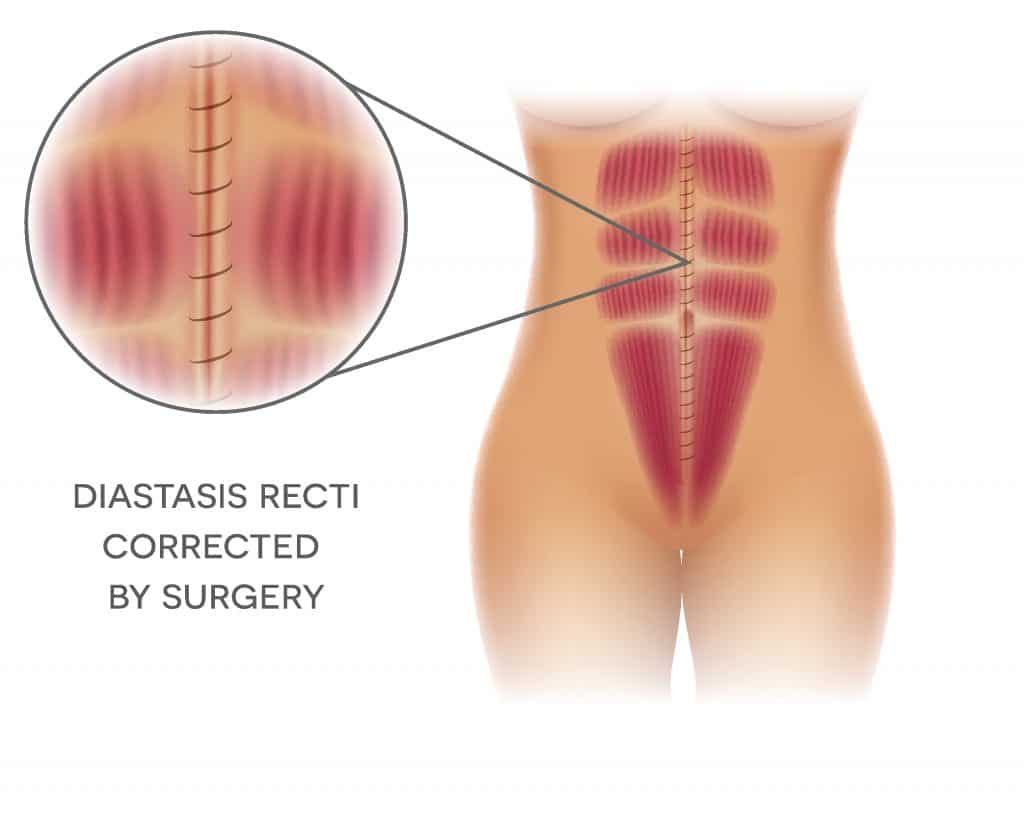
Next, I repair and tighten the rectus muscles. One of the main benefits of abdominoplasty is the ability to tighten the core. The rectus abdominis muscle is usually the one that is separated after pregnancy. It leaves a tear along the linea alba at the center of the tummy. Muscle separation from injury or weight loss can be in the same way.
Divarication of the rectus muscles is assessed. I first mark out the muscle edges above the Scarpa fascia. The tissue here will often be quite loose, which is what causes the belly bulge seen in patients with diastasis recti.
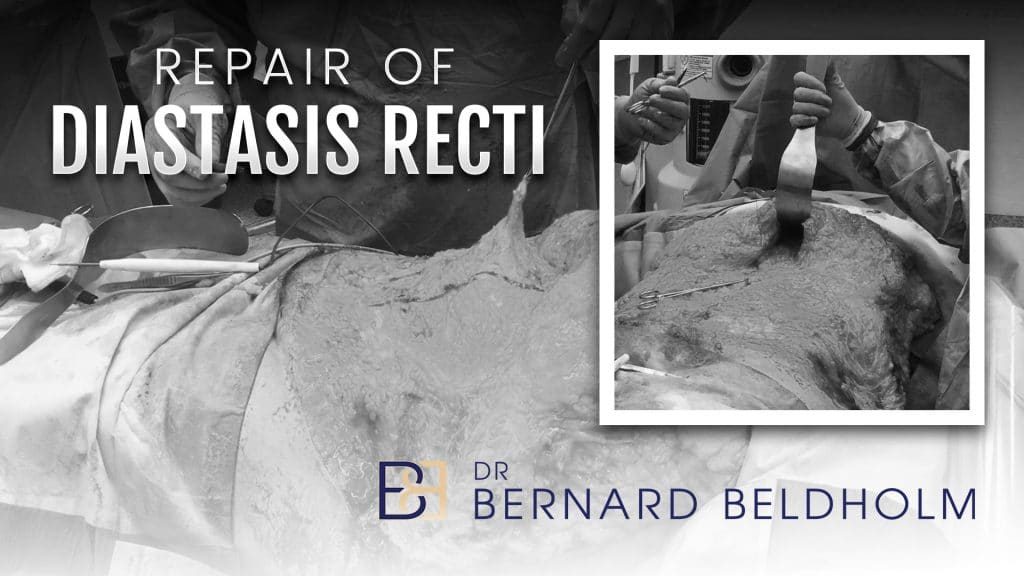
The separated muscles are brought together with permanent barbed sutures all the way down to the inferior skin edge. I use what is called a V-Loc suture. V-Loc 1 permanent sutures are useful because there is no need to tie knots, which means the patient does not have to worry about feeling palpable lumps and bumps in their tummy after the surgery. It also saves a bit of time and tediousness since I do not have to tie knots during surgery.
The tummy will become visibly tighter and flatter as you work your way toward the belly button with the sutures.
Step 4: Final dissection to treat remaining loose skin
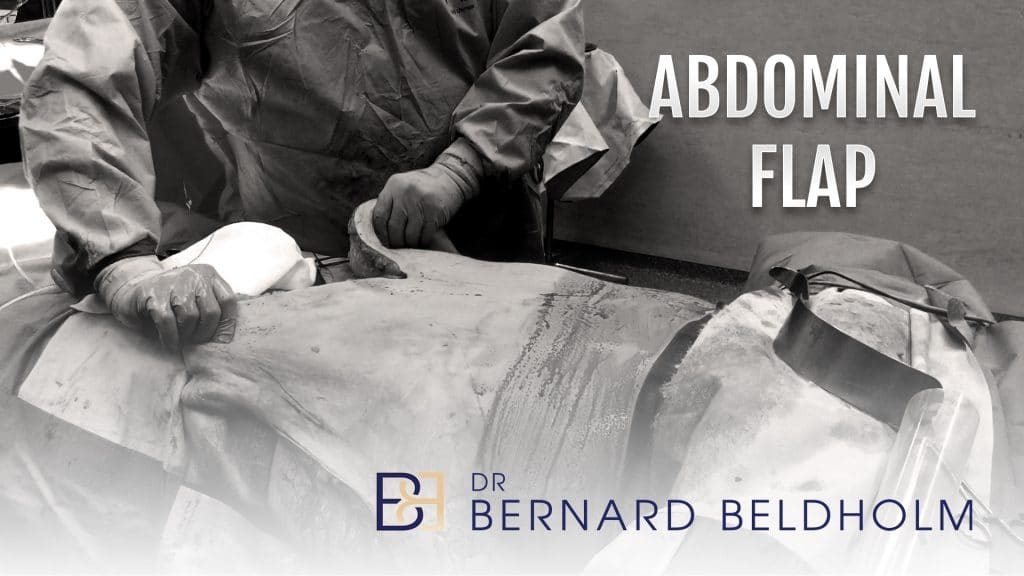
Once the abdominal wall is tightened, there will be further looseness of the skin. This will need a final dissection to make the skin taut and smooth. At this point, you will decide on the extent of skin resection.
Before completing this final step, the operating table can be adjusted at a slight bend so that the skin is closed under slight tension. Closing the skin under tension prevents overhangs of loose tissue and gives a better final result since the skin will relax out over the next 3-6 months post op.
The degree of bend can be somewhere around 15 degrees, though this will vary from patient to patient. It can even depend on the experience and preference of the surgeon. I have found that slimmer patient who have had less liposuction usually require less bend. For heavier patients that may have had a significant amount of liposuction, I tend to bend the table more because these patients often have more skin looseness in the months following surgery by comparison.
The skin is pulled down to the middle toward the pubis to make the upper abdomen tight. I use plication stitches, which help ensure that there is enough tightness in the upper abdomen. These stitches are absorbable, and they also help make closing the skin a bit easier. Another benefit is that stitching the skin down also lowers the chance of fluid collecting. The skin will be closed down the midline and trimmed.
Step 5: Creating the new umbilicus
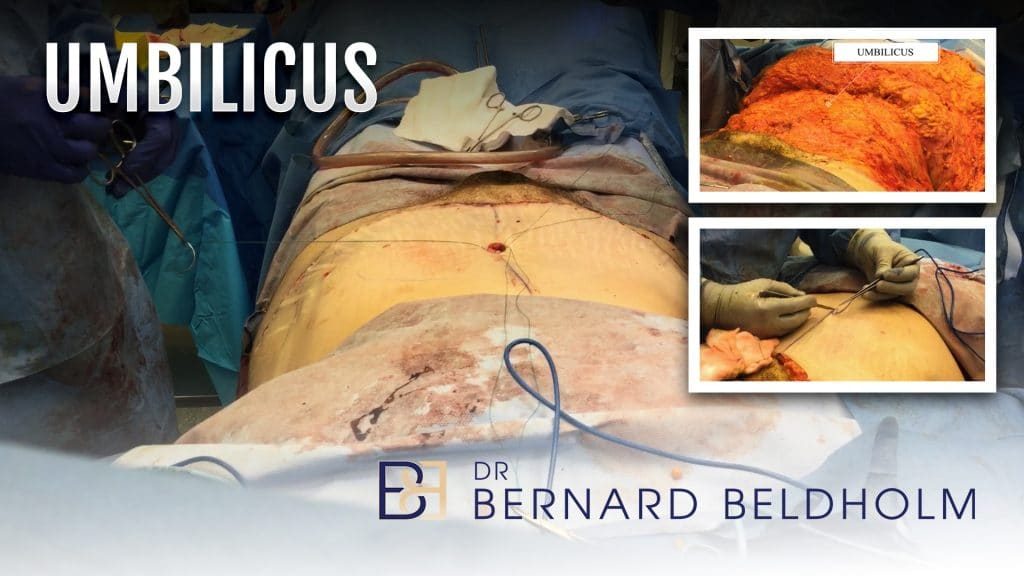
Next, I shape the umbilicus. Creating an umbilicusl is important to a successful aesthetic result The patient’s own belly button will be moved and reattached in the desired area. Older Abdominoplasty methods used to cut away the umbilicus entirely. Other outdated methods involved stretching the skin while leaving the belly button in place. This left the umbilicus in an unnatural position that made it obvious that the patient had a cosmetic surgery.
In this method, our goal is to place the umbilicus in a natural position. A piece of drain is stitched into the umbilical stalk with 2/0 Silk stitch. The purpose of this is to mark out the new umbilical position. By feeling the small plastic marker, I can identify where the new belly button position is on the skin.
Next, a small incision is made where the new belly button will be positioned. I mark out a new hole (oval, about 1.5 cm) where the umbilicus will come through.
Three sutures are used around the umbilical stalk. These are pulled through the hole that I created previously. ARTISS tissue glue is sprayed into the epigastric tunnel and a two minute compression is done. I bring the belly button through while pushing the skin down. Doing so allows the scar to be hidden inside the umbilical stalk. I use a Silk stay to stitch down the superior and inferior flaps. Once completed, I cut the stitch and remove the piece of drain from the umbilicus.
Step 6: Marking and removing the lower abdominal skin
One of the critical steps of the operation is marking out the extent of skin resection. The patient should be bent slightly (approximately 15 degrees or so, depending again on the patient) for the final flap closure and resection. The lower flap should be pulled firmly down. I use an alice forcep to mark out the extent of skin resection.
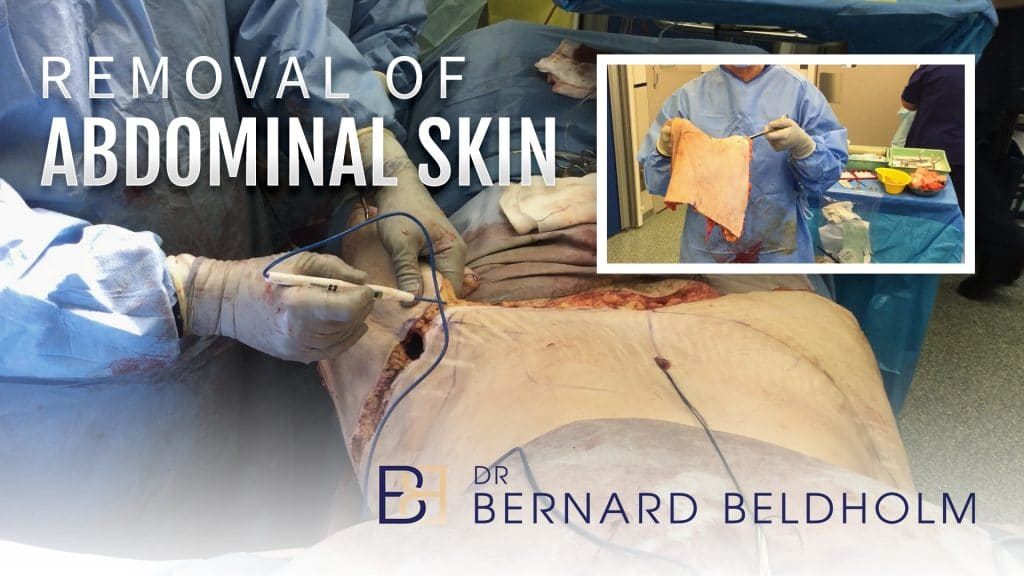
There are many methods for finalizing the skin markings and also special instruments. Some surgeons make multiple incisions in order to remove the skin in segments. I have found that I can reliably identify the extent of skin resection using the alice forceps. My assistant pulls the skin 45 degrees to the side, while I have the alice forceps attached to the lower skin. I then push up against the skin to feel out the bump.
Markings are done on both the right and left side. A small epithelial cuff is made on the superior skin flap by beveling the incision. Skin on the right and left side will then be resected.
Step 7: Closing the layers and Final refinement of the result
Finally, I close the tissue along the Scarpa fascia using permanent sutures. The Scarpa can tolerate quite a lot of tension, which holds everything together nicely. And now, for the end result: You should see a nice, flat tummy at this stage.
A look ahead: Improving patient outcomes
This drainless method preserves blood flow, limits dissection, and makes patient recovery easier. Abdominoplasty has undergone tremendous changes over the last several decades. There is no single “right” way to perform abdominoplasty.
References:
- Ferreira, António, et al. “Abdominoplasty With Scarpa Fascia Preservation.” Annals of Plastic Surgery, vol. 76, 4 June 2016, doi:10.1097/prs.0b013e3181d0ac59.
- Dutot, Marie-Charlotte, et al. “Improving Safety after Abdominoplasty.” Plastic and Reconstructive Surgery, vol. 142, no. 2, 2018, pp. 355–362., doi:10.1097/prs.0000000000004572.
- Heller, Justin B., et al. “Outcome Analysis of Combined Lipoabdominoplasty versus Conventional Abdominoplasty.” Plastic and Reconstructive Surgery, vol. 121, no. 5, 2008, pp. 1821–1829., doi:10.1097/prs.0b013e31816b1350.
- Hurvitz, Keith A, et al. “Evidence-Based Medicine: Abdominoplasty.” Plastic and Reconstructive Surgery, vol. 133, no. 5, May 2014, pp. 1214–1221., doi:10.1097/PRS.0000000000000088.
- Lockwood, Ted. “High-Lateral-Tension Abdominoplasty with Superficial Fascial System Suspension.” Plastic and Reconstructive Surgery, vol. 96, no. 3, 1995, pp. 603–615., doi:10.1097/00006534-199509000-00012.
- Quaba, Awf A., et al. “The No-Drain, No-Quilt Abdominoplasty.” Plastic and Reconstructive Surgery, vol. 135, no. 3, 2015, pp. 751–760., doi:10.1097/prs.0000000000001031.
- Smith, Lane F., and Lane F. Smith. “Safely Combining Abdominoplasty with Aggressive Abdominal Liposuction Based on Perforator Vessels.” Plastic and Reconstructive Surgery, vol. 135, no. 5, 2015, pp. 1357–1366., doi:10.1097/prs.0000000000001200.
- Sozer, Sadri Ozan, et al. “Abdominoplasty with Circumferential Liposuction.” Plastic and Reconstructive Surgery, vol. 142, no. 4, 2018, pp. 891–901., doi:10.1097/prs.0000000000004819.
- Swanson, Eric. “Prospective Outcome Study of 360 Patients Treated with Liposuction, Lipoabdominoplasty, and Abdominoplasty.” Plastic and Reconstructive Surgery, vol. 129, no. 4, 2012, pp. 965–978., doi:10.1097/prs.0b013e318244237f.
- Vieira, Brittany L., et al. “Is There a Limit? A Risk Assessment Model of Liposuction and Lipoaspirate Volume on Complications in Abdominoplasty.” Plastic and Reconstructive Surgery, vol. 141, no. 4, 2018, pp. 892–901., doi:10.1097/prs.0000000000004212.
